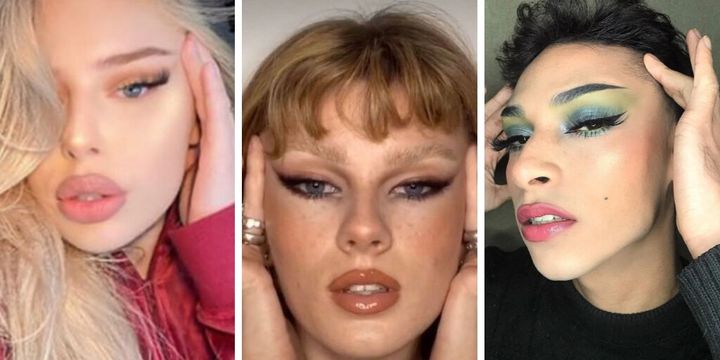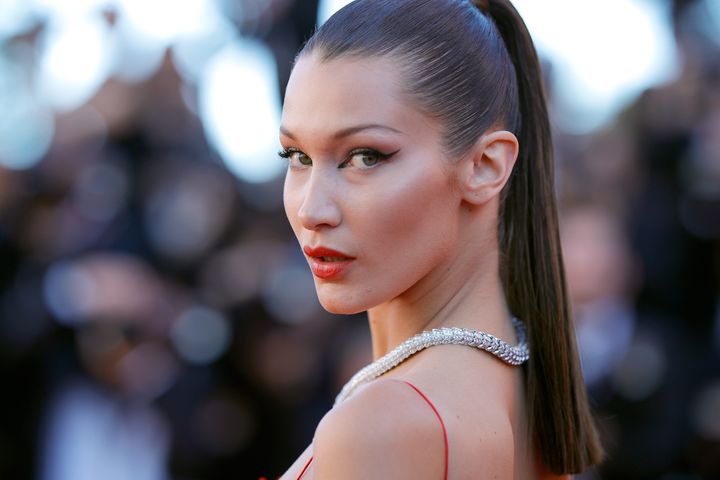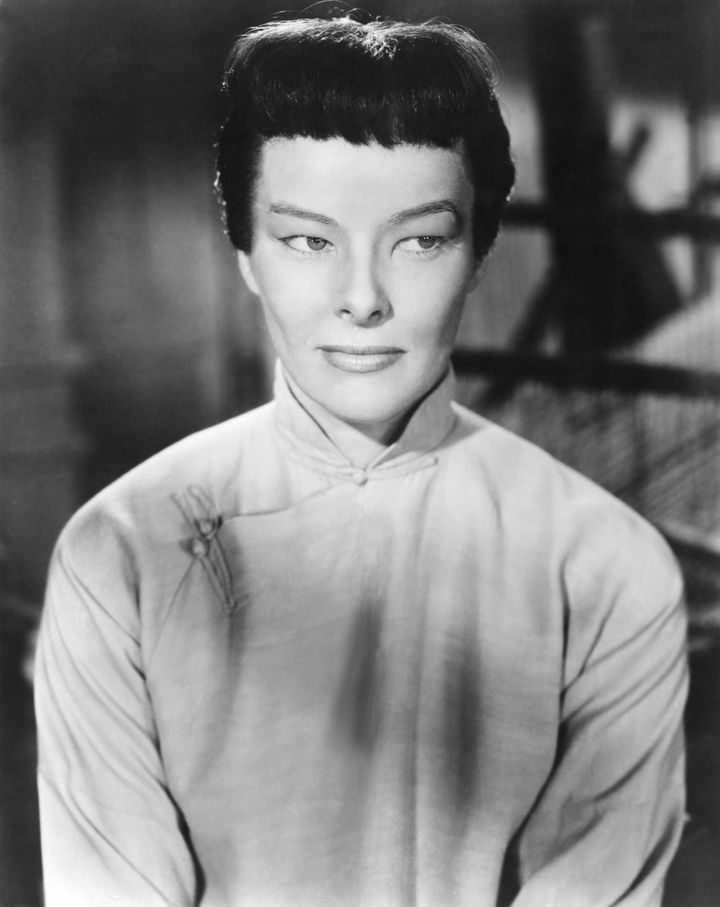
Growing up Asian in a predominantly white neighborhood, Eve Cong endured plenty of ridicule about the shape of her eyes.
“I can say that I love my features now, but growing up, society taught me to hate them,” the London-based actor told HuffPost. “My eyes were considered undesirable. Other kids would taunt me and other Asian kids by pulling their eyes up, down or sideways to mimic us and ridicule smaller eyes and slanted eyes. They’d ask us if we could see out of them.”
When the “fox eye” makeup trend started trending on social media, Cong said she was “triggered, to say the least.”
So what is it, exactly? It starts off with an application of angular eyeliner that many have claimed mimics the look of Asian eyes. But many influencers have taken it a step further, pulling their eyes back with their hands. Given the anti-Asian discrimination and even violence linked to the COVID-19 pandemic in the U.S. and U.K. lately, this trend is particularly controversial right now.
To achieve the fox-eye eyeliner look, makeup artists and novices alike try to achieve a different eye shape: The desired effect is something more elongated, sleek and slanted upward. Sometimes people will shave the ends of their eyebrows and redraw them straighter (the natural brow shape of many Asian people) and angled upward.
Some put a dash of eyeliner in the inner corner of the eyelid for an even more “exotic” effect. (The latter trick latter emphasizes the epicanthal folds, the bit of skin on the upper lid near the inner corner of the eye, that’s common among East Asians and Southeast Asians.)
The really committed may opt for thread lifts or Botox lifts, two non-surgical options that many suspect Instagram influencers and celebrities like Bella Hadid and Kendall Jenner have gotten to pull up their brow line.

If makeup fans and Instagram models had stopped there, Cong said, she would have shrugged her shoulders and let it be. (Other Asian women, including popular YouTube makeup artist Sherliza Moé, have shared similar sentiments.)
But oftentimes, people pull back their temples to give their eyes an even more exaggerated “slanted” look ― a gesture that’s all too familiar to Asians who’ve ever been ridiculed for “chinky eyes” in their childhoods.
“That gesture has never been used to praise our features,” Cong said. “It’s still used today to fortify racism against us. It can be traumatizing.”
What’s worse is when the person doing the gesture is wearing a sexy version of the qipao, a traditional Chinese sheath dress that fast fashion sites usually hawk as “Oriental” or “Asian-inspired” designs. (Cong and her friend Tsatska Enkhbayar, a data scientist at Facebook, recently started a petition calling for the e-stores like Pretty Little Thing and Boohoo to stop selling the garments, because of the harmful hyper-sexual stereotypes about Asian women they play on.)
Cong, like many others, finds the “eyes-pulled-back” gesture blatantly racist.
As one Twitter user wrote when influencer Emma Chamberlain was called out for doing it: “non asian people have been pulling their eyes back for years to make fun of natural asian eye shapes. The pose has been appropriated by white women to be ‘trendy’ & a symbol of beauty when really it’s a symbol of oppression for us.”
Asians have so reliably been mocked for their eyes that some have resorted to plastic surgery to give them a more European look: Blepharoplasty (aka double eyelid surgery) is a procedure that elevates the upper eyelids, removes fatty tissue and create an eyelid crease. (Makeup glue or tape achieve a similar “double eyelid” effect on the cheap.)
In 2013, TV journalist Julie Chen revealed on “The Talk” that she had double eyelid surgery to make her eyes look “less Chinese” after being pressured about her looks by a local news director early on in her career.
Given experiences along those lines, seeing white women try to make the upturned, “slanted” eye part of their aesthetic feels like a slap in the face. As critics see it, the “fox eye” trend is, at best, a played-out attempt to look “exotic.” At worst, it’s an example of cultural appropriation or just straight-up racist.
What counts as cultural appropriation?
Cultural appropriation happens when members of the dominant culture in a society co-opt or use the ideas, customs or identity markers of a less powerful or minority group, often inappropriately or without consent.
When you’re aware of the cultural baggage that comes with it ― that it’s led to deep insecurities in the Asian community and plastic surgeries ― pulling the skin up around your eyes to look “snatched” seems a lot less innocent.
Kelly H. Chong, a professor of sociology at the University of Kansas, thinks the trend flirts with appropriation.
“When you see the way cultural influencers are exoticizing, sexualizing and then legitimizing the ‘fox eye’ look as a ‘cool’ style trend, you can clearly see the kind of power of the dominant group wields in society,” she told HuffPost. “Influencers are commodifying it for consumption, visual and material, by the mainstream public.”
Many makeup artists stand by their work, though ― even the eye-pulling gesture.
“To me, ‘fox eye’ is like a fox’s elongated eyes and not intended to be a racial gesture to Asian,” said Tracy Smith, a makeup artist in the U.K. “For me, the hand placement is to add the photography ‘triangle’ shape composition to complement my pics.”
Smith says she sympathizes with people’s complaints, but that sometimes a trend is just a trend.
“I think there needs to be a better understanding that trends exist as trial runs, especially for beauty influencers and makeup artists,” she said.
Susan Scafidi, the founder and academic director of the Fashion Law Institute at Fordham Law School and the author of “Who Owns Culture?: Appropriation and Authenticity in American Law,” said fox eye and thread lifts fall outside the rubric of cultural appropriation because eye shape is a physical rather than cultural trait.
“Mimicry of physical appearance associated with race can appear alongside cultural appropriation; however, a person’s culture is not determined by or limited to physical traits,” she said.
That said, Scafidi does think it raises a concern similar to the misappropriation of dress, hairstyle and other cultural attributes.
“It’s an example of mainstream adoption of an attribute associated with a group of people at the same time that society still discriminates against the people themselves,” she said. “Fashion may embrace braids but not a Black model; feathers but not an Indigenous designer; fox eyes but not an Asian makeup artist.”
“That gesture has never been used to praise our features. It’s still used today to fortify racism against us. It can be traumatizing.”
- Eve Cong, actor
For the adopter (or appropriator, depending on how you see it), the action is usually couched in flattery, Scafidi said: “It’s an homage! It’s appreciation, not appropriation.” “I just love their eyes/hair/style!”
But those statements tend to whitewash how the dominant culture has long mocked those very physical or cultural characteristics and used them to justify excluding people of color, according to Scafidi.
In some ways, Scafidi argues the makeup trend alone could be seen as a step toward more inclusive standards of beauty. (Plus, as she noted, the “cat eye” ― the fox eye’s currently less-talked about older sister ― is iconic, with historic antecedents going at least as far back as Cleopatra).
It’s the accompanying racially charged gesture that absolutely takes the trend into “faux pas” territory, Scafidi said.
Are fox eyes just the new yellowface?
Trends like “fox eye” are nothing new. The makeup challenge calls to mind Blackfishing, a buzzy term we’re quick to shout out whenever a white celebrity adopts the characteristics associated with a Black person’s phenotype for commercial gain ― a dark spray tan, for instance, coupled with cornrows. (For prominent examples, see pretty much any Kardashian-Jenner sister.)
But more on-point, the trend tracks with Hollywood’s ugly history of yellowface. For decades, white entertainers have donned theatrical makeup and costumes to perform hokey versions of Asian-ness, just as they mocked Black and Native people by employing blackface and redface.
Katharine Hepburn’s turn in 1944’s “Dragon Seed” is a notorious example of yellowface. To play Chinese heroine “Jade,” Hepburn’s eyelids were aggressively taped and puttied into submission. Years later, in 1961, comedian Mickey Rooney sported similarly exaggerated makeup (and a buck-tooth for good measure) and squinted his way through his portrayal of Mr. Yunioshi, Audrey Hepburn’s irascible Japanese landlord in “Breakfast at Tiffany’s.”
Interestingly, the studio makeup pros who perfected yellowface used a kind of proto “foxy eye” technique, Chong said. They’d shave the ends of white actors’ eyebrows off and redraw the brow upward or straight across, to get a distinctly “Asian” look.
“I think there is a direct line between yellowface and this makeup trend,” she said.

What bothers Chong most about old-school yellow face and the current “fox eyes” craze is how Asian people get called over-reactors when they object to either.
“Yellowface is no less offensive than blackface or redface ― but up until recently, it’s seemed like people have gotten a cultural free pass to commit the former, and exploit Asian identities in general.” (See: Cliche “orientalism” couture and styling at the Met Gala and white-faced geisha editorials in Vogue, or slapping a bindi on your forehead at a desert music festival and calling it a “look.”)
“To me, this is the biggest problem and challenge facing Asian-ethnics today; that racism and racist behavior against Asians are far more unrecognized and acceptable than racism against other people of color,” Chong said.
This is one reason why any controversy about the fox eye trend even exists, she added.
“The general public has an inability to recognize that the more extreme forms of “Orientalizing” by makeup artists who do fox eye is in fact highly offensive and hurtful to Asian-ethnics,” she said.
When a community voices its concern or unease about something, Nishime wishes people would listen.
“Yellowface is no less offensive than blackface or redface ― but up until recently, it’s seemed like people have gotten a cultural free pass to commit the former, and exploit Asian identities in general.”
- Kelly H. Chong, a professor of sociology at the University of Kansas
Mar Cantos, a makeup artist with a following on Instagram, has shared some “foxy eye” content in the past, but ever since she’s become aware of its potentially racist implications, she’s been warier of where she puts her hands and how exaggerated she goes with the overall look.
“I can absolutely see the criticism of the trend,” she said. “I’ve come across this gesture repeatedly in the beauty industry for a while now, but I didn’t link them together until it was brought up online.”
“I still think I did it as in cultural appreciation rather than appropriation, but I really try to be careful how I pose,” she added.
Finding out why there’s baggage or hurt associated with something that somebody objects to — and then course-correcting — is a big first step, Chong said.
“In most cases, the dominant group’s adoption of these cultural practices occurs without much understanding of the history and the original cultural meaning of these practices,” she said. “It usually results in misrepresentation, if not distortion, of the meaning of these cultural elements ― regardless of the intent of the appropriator.”
“When you learn the history of [the gesture] and know how it perpetuates harmful stereotypes of a minority group, it’s no wonder that such appropriation is offensive to people,” Chong said.